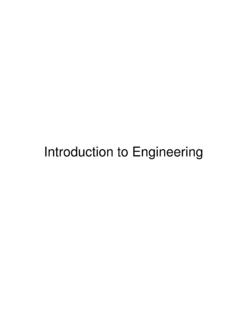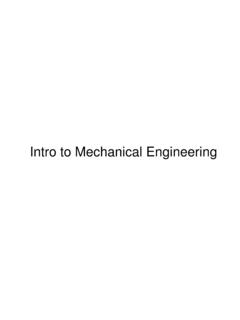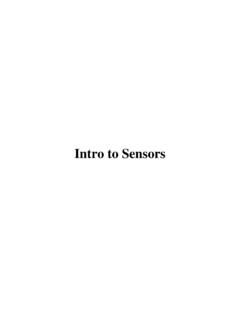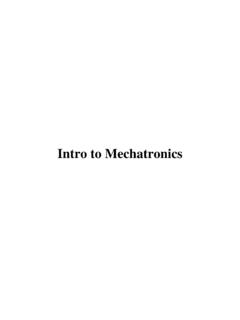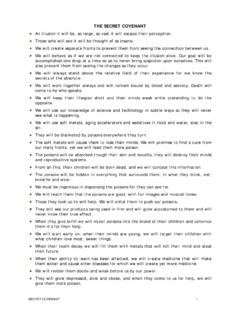Transcription of RLocus Analysis Design - New York University
1 MechatronicsRoot Locus Analysis and DesignK. Craig1 Root Locus Analysis & Design A designer would like: To know if the system is absolutely stable andthe degree of stability. To predict a system s performance by an Analysis that does NOT require the actual solution of the differential equations. The Analysis to indicate readily the manner or method by which this system must be adjusted or compensated to produce the desired performance Locus Analysis and DesignK. Craig2 Two Methods are available: Root-Locus Approach Frequency-Response Approach Root Locus Approach Basic characteristic of the transient response of a closed-loop system is closely related to the location of the closed-loop poles.
2 If the system has a variable loop gain, then the location of the closed-loop poles depends on the value of the loop gain Locus Analysis and DesignK. Craig3 It is important to know how the closed-loop poles move in the splane as the loop gain is varied. From a Design Viewpoint: Simple gain adjustment may move the closed-loop poles to desired locations. The Design problem then becomes the selection of an appropriate gain value. If gain adjustment alone does not yield a desired result, addition of a compensator to the system is necessary. The closed-loop poles are the roots of the closed-loop system characteristic Locus Analysis and DesignK.
3 Craig4 The Root Locus Plotis a plot of the roots of the characteristic equation of the closed-loop systemfor all values of a system parameter, usually the gain; however, any other variable of the open-loop transfer function may be used. By using this method, the designer can predict the effects on the location of the closed-loop poles of varying the gain value OR adding open-loop poles and/or open-loop zeros. A designer MUST know how to generate the root loci of the closed-loop system BOTH by hand and with a computer ( , MatLab).MechatronicsRoot Locus Analysis and DesignK. Craig5 Experience in sketching the root loci by hand is invaluable for interpreting computer-generated root loci, as well as for getting a rough idea of the root loci very Locus Analysis and DesignK.
4 Craig6 Underlying Principle: Poles of the closed-loop transfer function are related to the zeros and poles of the open-loop transfer function and also to the gain. The values of sthat make the open-loop transfer function equal to 1 must satisfy the characteristic equation of the closed-loop system . The root-locus plot clearly shows the contributions of each open-loop pole and zero to the locations of the closed-loop Locus Analysis and DesignK. Craig7 The root-locus plot also shows the manner in which the open-loop poles and zeros should be modified so that the response meets system performance Locus Analysis and DesignK.
5 Craig8 Example:()()()oAsKJG(s)BEsssassJ ===+ + ()2n222nnC(s)KKR(s)ss2Ks2sKs2s ===+++++ + n1K K = =Assume a = Position Control SystemMechatronicsRoot Locus Analysis and DesignK. Craig9 Problem:Determine the roots of the characteristic equation for all values of K and plot these roots in the s ,2s11K= Roots of the characteristic equation are given by:Note:s = -2 and s = 0 are the open-loop polesRoot-LocusPlotMechatronicsRoot Locus Analysis and DesignK. Craig10 For 0 < K < 1, the roots are real and lie on the real axis. For K > 1, the roots are complex. Once the root-locus plot has been obtained, it is possible to determine the variation in system performance with respect to a variation in ,2nn1,2dC(s)R(s)s2ssi1si =+ + = = MechatronicsRoot Locus Analysis and DesignK.
6 Craig11 As K is increased from K = 1, we observe: A decrease in the damping ratio . This increases the overshoot of the time response. An increase in the undamped natural frequency n. An increase in the damped natural frequency d. No effect on the rate of decay . No matter how much the gain is increased in this simple linear second-order system , the system can never become Locus Analysis and DesignK. Craig12()tdddyt1ecostsint = + ()() rise settling timeMe 01 overshoot1 = < = Second-Order SystemUnit Step ResponseMechatronicsRoot Locus Analysis and DesignK. Craig13 Constant Parameter Curves on the S PlaneMechatronicsRoot Locus Analysis and DesignK.
7 Craig14 Time-Response Specifications vs. Pole-Location () MechatronicsRoot Locus Analysis and DesignK. Craig15 General effects of the addition of poles: pull root locus to the right lower system s relative stability slow down the settling of the response Compare root locus plots of:()()()()111(s4)s4(s2)s+4s2s1 +++++MechatronicsRoot Locus Analysis and DesignK. Craig16 General effects of the addition of zeros: pull root locus to the left makes system more stable speed up the settling of the response Compare root locus plots of:1(s6)(s4)(s2)(s1)(s4)(s2)(s1)(s3)( )(s4)(s2)(s1)(s4)(s2)(s1)+ ++++++++ ++++++MechatronicsRoot Locus Analysis and DesignK.
8 Craig17 Time (sec.)AmplitudeStep : U(1)To: Y(1)2zs1G(s)ss1+=++Increasing zz = 0, , , , MechatronicsRoot Locus Analysis and DesignK. Craig18 Frequency (rad/sec)Phase (deg); Magnitude (dB)Bode Diagrams-80-60-40-20020 From: U(1)10-210-1100101102-200-150-100-50050T o: Y(1)2zs1G(s)ss1+=++Increasing zIncreasing zz = 0, , , , MechatronicsRoot Locus Analysis and DesignK. Craig19 Time (sec.)AmplitudeStep : U(1)To: Y(1)Increasing p21G(s)(ps1)(ss1)=+++p = 0, , , , MechatronicsRoot Locus Analysis and DesignK. Craig20 Frequency (rad/sec)Phase (deg); Magnitude (dB)Bode Diagrams-150-100-50050 From: U(1)10-210-1100101102-300-200-1000To: Y(1)21G(s)(ps1)(ss1)=+++Increasing pIncreasing pp = 0, , , , MechatronicsRoot Locus Analysis and DesignK.
9 Craig21 Root-Locus Plots: Angle & Magnitude Conditions+- C(s)R(s)Gc(s)G(s)H(s)E(s)B(s)D(s) ++()()()()()()()ccCsGsGsRs1 GsGsHs=+MechatronicsRoot Locus Analysis and DesignK. Craig22 The characteristic equation of the closed-loop system is: Here we assume that Gc(s)G(s)H(s) is a ratio of polynomials in s. Gc(s)G(s)H(s) is a complex quantity: Angle Condition Magnitude Condition()()()()()()cc1 GsGsHs0 GsGsHs1+== ()()()()()cGsGsHs1802k1 k = 0, 1, 2, .. = +o()()()cGsGsHs1=MechatronicsRoot Locus Analysis and DesignK. Craig23 The values ofs that fulfill both the angle and magnitude conditions are the roots of the characteristic equation, or the closed-loop poles.
10 A plot of the points of the complex plane satisfying the angle condition alone is the root locus. The roots of the characteristic equation (the closed-loop poles) corresponding to a given value of the gain can be determined from the magnitude Locus Analysis and DesignK. Craig24 Gc(s)G(s)H(s) often involves a gain parameter K and the characteristic equation may be written as: The root loci for the system are the loci of the closed-loop poles as the gain K is varied from zero to infinity . To begin sketching the root loci we must know the location of the poles and zeros of Gc(s)G(s)H(s).()()()()()()12m12nKszszsz1 0spspsp++++=+++LLMechatronicsRoot Locus Analysis and DesignK.



